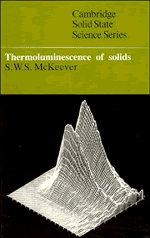Book contents
- Frontmatter
- Contents
- Preface
- 1 Introduction
- 2 Theoretical background
- 3 Thermoluminescence analysis
- 4 Additional factors governing thermoluminescence
- 5 Defects and thermoluminescence
- 6 Thermoluminescence dosimetry (TLD)
- 7 Thermoluminescence dating
- 8 Geological applications
- 9 Instrumentation
- Appendix A Minerals
- Appendix B Commercial thermoluminescence systems
- References
- Index
6 - Thermoluminescence dosimetry (TLD)
Published online by Cambridge University Press: 04 April 2011
- Frontmatter
- Contents
- Preface
- 1 Introduction
- 2 Theoretical background
- 3 Thermoluminescence analysis
- 4 Additional factors governing thermoluminescence
- 5 Defects and thermoluminescence
- 6 Thermoluminescence dosimetry (TLD)
- 7 Thermoluminescence dating
- 8 Geological applications
- 9 Instrumentation
- Appendix A Minerals
- Appendix B Commercial thermoluminescence systems
- References
- Index
Summary
The application of the phenomenon of thermoluminescence to the measurement of absorbed radiation dose has progressed a great deal since the initial work by Daniels and colleagues referred to in chapter 1. Several thermoluminescent phosphors are now used routinely in many dosimetric applications. This chapter deals with the characteristics of thermoluminescence dosimetry (TLD) materials and several of their uses (environmental monitoring, personal dosimetry and medical applications). To begin with, it is useful to examine what properties are looked for when assessing the quality of a new TLD material.
General requirements for TLD materials
The selection of a phosphor for a thermoluminescence dosemeter requires a precise knowledge of the particular application being considered. Broadly, the applications may be conveniently listed as personal dosimetry (dose estimate in body tissue) and environmental Monitoring (dose estimate in air), with special considerations for medical applications and reactor dosimetry. Clearly there are large areas of overlap between each usage. Modern dosemeters are manufactured with specific applications in mind, for instance, measurement of the low-energy X-ray or β dose absorbed by the epidermis at a depth of 5 mg cm−2 (~ 50 μm) below the surface of the skin, or assessment of the dose-equivalent from a mixed neutron field absorbed by body tissue at a depth of 1000 mg cm−2. To make these measurements within an acceptable uncertainty limit, correct choice of dosemeter is essential.
Several recommended standards have been suggested for dosemeter performance, depending upon the application.
- Type
- Chapter
- Information
- Thermoluminescence of Solids , pp. 205 - 252Publisher: Cambridge University PressPrint publication year: 1985
- 1
- Cited by



